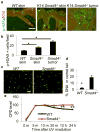Smad4 loss in mouse keratinocytes leads to increased susceptibility to UV carcinogenesis with reduced Ercc1-mediated DNA repair
- PMID: 23648546
- PMCID: PMC3783584
- DOI: 10.1038/jid.2013.213
Smad4 loss in mouse keratinocytes leads to increased susceptibility to UV carcinogenesis with reduced Ercc1-mediated DNA repair
Abstract
Smad4 loss occurs frequently in human skin squamous cell carcinoma (SCC), but it is unknown whether this loss increases UV-induced carcinogenesis, a major etiological factor in skin cancer. In the present study, mice with keratinocyte-specific Smad4 deletion (K14.Smad4(-/-)) and wild-type (WT) littermates were chronically UV-irradiated. Compared with WT, K14.Smad4(-/-) mice exhibited increased DNA damage and increased susceptibility to UV-induced skin cancer. Among genes involved in repairing UV-induced DNA damage, Excision repair cross-complementation group 1 (Ercc1) messenger RNA was significantly reduced in UV-treated K14.Smad4(-/-) skin compared with WT skin. Further analysis revealed that Smad4 loss confers reduced Snail binding to the Ercc1 regulatory elements, resulting in reduced Ercc1 transcription. Consistently, transient transfection of Snai1 into Smad4(-/-) keratinocytes led to increased repair of UV-induced DNA lesions. Transfection of Ercc1 into Smad4(-/-) keratinocytes restored repair of UV-induced DNA damage. Further, immunostaining revealed that the presence of Smad4 protein is associated with the presence of Snail and Ercc1 proteins in human skin SCC and precancerous actinic keratoses. Collectively, Smad4 loss-associated Snail reduction compromises Ercc1-mediated DNA repair, contributing to increased UV-induced skin carcinogenesis. Thus, we identified a role for Snail in UV-induced DNA repair.
Conflict of interest statement
The authors declare no conflict of interest.
Figures





Similar articles
-
Topical thymidine dinucleotide application protects against UVB-induced skin cancer in mice with DNA repair gene (Ercc1)-deficient skin.DNA Repair (Amst). 2009 May 1;8(5):664-71. doi: 10.1016/j.dnarep.2009.01.020. Epub 2009 Mar 4. DNA Repair (Amst). 2009. PMID: 19264557
-
Epidermal Rac1 regulates the DNA damage response and protects from UV-light-induced keratinocyte apoptosis and skin carcinogenesis.Cell Death Dis. 2017 Mar 9;8(3):e2664. doi: 10.1038/cddis.2017.63. Cell Death Dis. 2017. PMID: 28277539 Free PMC article.
-
Mice with skin-specific DNA repair gene (Ercc1) inactivation are hypersensitive to ultraviolet irradiation-induced skin cancer and show more rapid actinic progression.Oncogene. 2006 Oct 12;25(47):6229-38. doi: 10.1038/sj.onc.1209642. Epub 2006 May 8. Oncogene. 2006. PMID: 16682947
-
UV-Induced Molecular Signaling Differences in Melanoma and Non-melanoma Skin Cancer.Adv Exp Med Biol. 2017;996:27-40. doi: 10.1007/978-3-319-56017-5_3. Adv Exp Med Biol. 2017. PMID: 29124688 Review.
-
Ultraviolet damage, DNA repair and vitamin D in nonmelanoma skin cancer and in malignant melanoma: an update.Adv Exp Med Biol. 2014;810:208-33. doi: 10.1007/978-1-4939-0437-2_12. Adv Exp Med Biol. 2014. PMID: 25207368 Review.
Cited by
-
A Study of Sperm DNA Damage Mechanism Based on miRNA Sequencing.Am J Mens Health. 2024 Sep-Oct;18(5):15579883241286672. doi: 10.1177/15579883241286672. Am J Mens Health. 2024. PMID: 39462893 Free PMC article.
-
Type I Interferons Enhance the Repair of Ultraviolet Radiation-Induced DNA Damage and Regulate Cutaneous Immune Suppression.Int J Mol Sci. 2022 Feb 5;23(3):1822. doi: 10.3390/ijms23031822. Int J Mol Sci. 2022. PMID: 35163747 Free PMC article.
-
Methylation status, mRNA and protein expression of the SMAD4 gene in patients with non-melanocytic skin cancers.Mol Biol Rep. 2023 Sep;50(9):7295-7304. doi: 10.1007/s11033-023-08656-2. Epub 2023 Jul 10. Mol Biol Rep. 2023. PMID: 37428273
-
The role of TGF-β/SMAD4 signaling in cancer.Int J Biol Sci. 2018 Jan 12;14(2):111-123. doi: 10.7150/ijbs.23230. eCollection 2018. Int J Biol Sci. 2018. PMID: 29483830 Free PMC article. Review.
-
A miR-590/Acvr2a/Rad51b axis regulates DNA damage repair during mESC proliferation.Stem Cell Reports. 2014 Dec 9;3(6):1103-17. doi: 10.1016/j.stemcr.2014.10.006. Epub 2014 Nov 20. Stem Cell Reports. 2014. PMID: 25458897 Free PMC article.
References
-
- Batlle E, Sancho E, Franci C, Dominguez D, Monfar M, Baulida J, et al. The transcription factor snail is a repressor of E-cadherin gene expression in epithelial tumour cells. Nature cell biology. 2000;2:84–9. - PubMed
-
- Berton TR, Wang XJ, Zhou Z, Kellendonk C, Schutz G, Tsai S, et al. Characterization of an inducible, epidermal-specific knockout system: differential expression of lacZ in different Cre reporter mouse strains. Genesis. 2000;26:160–1. - PubMed
-
- Cano A, Perez-Moreno MA, Rodrigo I, Locascio A, Blanco MJ, del Barrio MG, et al. The transcription factor snail controls epithelial-mesenchymal transitions by repressing E-cadherin expression. Nature cell biology. 2000;2:76–83. - PubMed
Publication types
MeSH terms
Substances
Grants and funding
LinkOut - more resources
Full Text Sources
Other Literature Sources
Medical
Molecular Biology Databases
Research Materials
Miscellaneous

